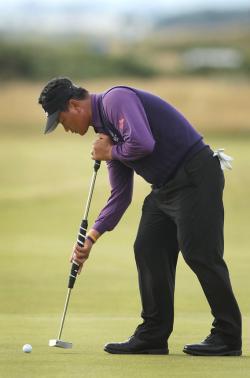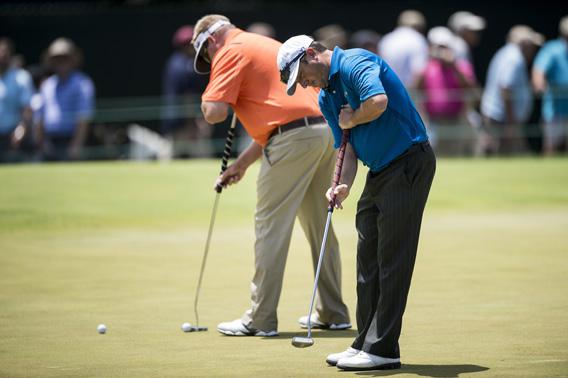Webb Simpson won the 2012 U.S. Open with an anchored putter. Adam Scott did the same at this year’s Masters. If either player used the same technique a few years from now, he’d be penalized, branded a rule-breaker, and possibly slapped across the face with a golf glove for dishonoring his sport. As of Jan. 1, 2016, anchoring one’s putter—that is, in the words of the president of the United States Golf Association, “intentionally securing one end of the club against the body, and creating a point of physical attachment around which the club is swung”—will be banned by the USGA and the R&A.
Why have the game’s twin governing bodies vowed to stop the practice of affixing the butt end of one’s putter to the stomach, forearm, or chin? “Rule 14-1b protects one of the important challenges in the game—the free swing of the entire club,” explained USGA president Glen Nager late last month. “The traditional stroke involves swinging the club with both the club and gripping hands held away from the body, requiring the player to direct and control the movement of the entire club.”
Tradition in golf is a tradition unlike any other. It is the sledgehammer that the sport’s adherents bludgeon us with, in pursuit of an ideal state of unchangedness they long to achieve. So, naturally, the nontraditional practice of anchoring the putter must be excised from the game. As the USGA’s helpful infographic points out, the claw, cross-handed, and—of course—“traditional” grips are still permitted.
There’s nothing more traditional in the grand old game, in fact, than banning goofy putting practices. Consider the case of the croquet-style stroke, which the sport’s protectors banned 45 years ago because, as the then executive director of the USGA put it, “the game of golf was becoming bizarre.” Heaven forfend!
In the early 1960s, an Oregonian named Bob Duden decided the traditional putting stance—feet off to the side, one eye pointed in the direction of the cup—didn’t make much sense. Rather than succumb to orthodoxy, Duden began to straddle the line of his putts. By placing his feet on either side of the ball, he was able to look at the hole with both eyes, enabling him to better read which way his putts would roll. The golfing pioneer also invented a putter, “The Dude,” that featured a large kink in the middle of the shaft—a shape that helped keep the club’s face square and generate a repeatable, pendulum-like swing.
In 1966, a couple of years after The Dude’s debut, Sam Snead gave croquet putting a try. Slammin’ Sammy, by then in his mid-50s, was known for his beautiful swing but had long struggled with yips on the green. As you can see in this video, Snead took the croquet style to new lows.
The spry old-timer stands directly behind the ball, his putter between his legs. He then contorts his body into the shape of a question mark, anchoring the flatstick with his top hand and moving it forward with his bottom hand—an approach that golfer Jimmy Demaret said was reminiscent of basting a turkey. “I putt better this cockeyed way,” Snead explained to Sports Illustrated in 1967. “Not too many people can bend over quite as well as I can, but I think it is good for old golfers. They don’t have to coordinate two hands, only one.” And as he told the AP that same year, there was an additional benefit: “I can read the green much better with my croquet style because my eyes are so much closer to the putting surface.”
Before Snead got to stooping, the croquet crowd hadn’t attracted much notice from the USGA. But as Al Barkow explains in Sam: The One and Only Sam Snead, the straw-hatted, seven-time major champion was a famous name, a player whose actions could inspire widespread adoption of an unorthodox technique. At the 1967 Masters, the legendary Bobby Jones—a man who, according to the Atlanta History Center, “called singular attention to the game’s best traditions”—threw a conniption at the sight of Snead’s bizarro methodology. According to Barkow, “Jones sat with Sam in a golf cart and told him that the putting style he had adopted didn’t look like golf.” Jones mentioned his objection to USGA executive director Joe Dey, who “took up St. Bobby’s observation and set in motion the process of banning croquet putting.”
Despite the protestations of Snead, Gary Player (“I don’t believe you should put a man down to hitting the ball one way”) and Jack Nicklaus (“This is ridiculous. Why don’t they just let us tee up the ball and play it?”), the croquet prohibition went into effect in January 1968. The new golf commandment both banned croquet-style putters like The Dude and decreed that it was henceforth illegal to straddle the ball on the green. “[F]or the first time in golfing history,” as Sports Illustrated explained in a 1967 feature, “the game’s ruling bodies were telling a man how he had to hit the ball.” Dey told SI that a full-on ban “was the only way to eliminate the unconventional styles that have developed in putting. The game of golf was becoming bizarre. It was some other game, part croquet, part shuffleboard, and part the posture of Mohammedan prayer.” Croquet putting had been banned, essentially, because a couple of old guys thought it looked dumb.
(Not every golfing powerbroker agreed with Dey. Prescott Bush, the father of George H.W. Bush and the head of the USGA in the 1930s, publicly disavowed his ruling. “It simply makes golf enjoyable and takes away the suffering,” Bush told SI. “I mean the real suffering that comes from that lack of confidence, that panic on the backstroke, that thrust called the yip. I believe it is good for the game of golf to have more people enjoy it. We should encourage any grip or stance that will add to the pleasure of the play.”)

Photo by Andrew Redington/Getty Images
Refusing to be cowed completely, Snead switched to a side-saddle approach, using the same croquet swing without straddling the line of the putt. But without the added benefit of standing directly behind the ball, the allure of croquet quickly dissipated. In 2010, K.J. Choi (seen to the left) briefly experimented with Snead-esque, side-saddle putting, but abandoned it after a few tournaments. Now it’s promoted by a few lonely converts on the Web who sell specialized equipment and extol the virtues of “face-on putting.”
This is the fate of innovation in golf: Anything interesting is a crime against the game. These affronts to the sport are most often perpetrated on the green, the most frustrating realm in sports. Long before the birth of the croquet putter and the anchored stroke, a player “putted” using a billiard cue at the 1895 U.S. Amateur; the pool hall gambit was quickly deemed illegal. Putting with a cue or a croquet mallet is the equivalent of tossing up a granny-style free throw—an embarrassing surrender to the impossibility of what appears to be a simple task. But while every basketball player this side of Rick Barry is too embarrassed to shoot underhanded, golfers have no shame—they’ll do anything to get the damned ball in the hole.
That includes anchoring a long putter against the torso, or any other body part that does the trick. Anchored putting isn’t new—as this photo shows, duffers have done it since at least the early 20th century. So why was tradition suddenly invoked in 2013? Because, just as in the case of the croquet stroke, anchored putting was threatening to get too popular. Four of the last six major winners have used anchored strokes, and a bunch of PGA Tour stars, including Webb Simpson and Keegan Bradley, have adopted the approach as youngsters rather than as a yips-defeating concession to old age. This was no longer a novelty—it was a threat.
In most every sport, techniques change as athletes experiment with novel ways to achieve the game’s goals. In basketball, the set shot gradually gave way to the jump shot. After Dick Fosbury leaped to the 1968 gold medal, his fellow high jumpers abandoned the straddle style for the Fosbury flop.
In golf, however, the players don’t control how the game is played. Golf has changed a bit over the last 500 years or so—as Tim Clark, who uses an anchored putter, says to those who believe tradition is important, “Well, why aren’t we playing hickory shafts and a feathery golf ball and having a goat carry our golf bag.” The goats notwithstanding, the game is still more suspicious of modernity than any other. Casey Martin, who can barely walk on account of a birth defect, had to go to the Supreme Court to get the right to use a cart during PGA Tour events. Now, Clark and others are saying that they, too, see a lawsuit as a potential remedy. (In his Sam Snead biography, Al Barkow argues that the croquet ban “might well have been actionable if a professional had wanted to take it to court.” That was never tested, though, as nobody chose to sue. And sports lawyer Michael McCann counters that anchored putter litigation wouldn’t be likely to succeed, as “courts give pro sports leagues a great deal of autonomy in their rules of competition.”)
I’m sympathetic to Tim Clark and his anchoring compatriots. A small group of men at the USGA and R&A ensure that most anything new and different that happens on a golf course gets stifled and shut down, lest the game ever change. I believe that the men who populate golf’s smoke-filled rooms are suspicious of anything that purports to make golf easier—that any technology or technique that might make you play better (square grooves, for instance) amounts to cheating. Croquet putting and anchored putting might confer an advantage, or they might not—studies have been inconclusive, and the sample sizes have been small. Thanks to the USGA, we’ll never have to find out.
